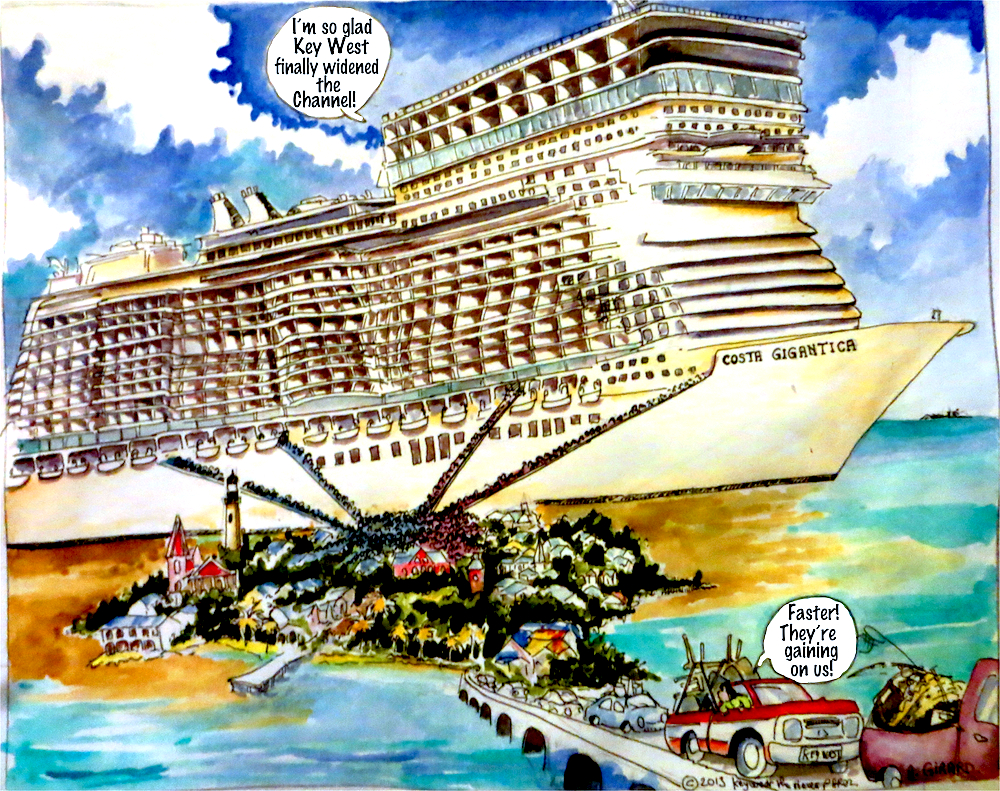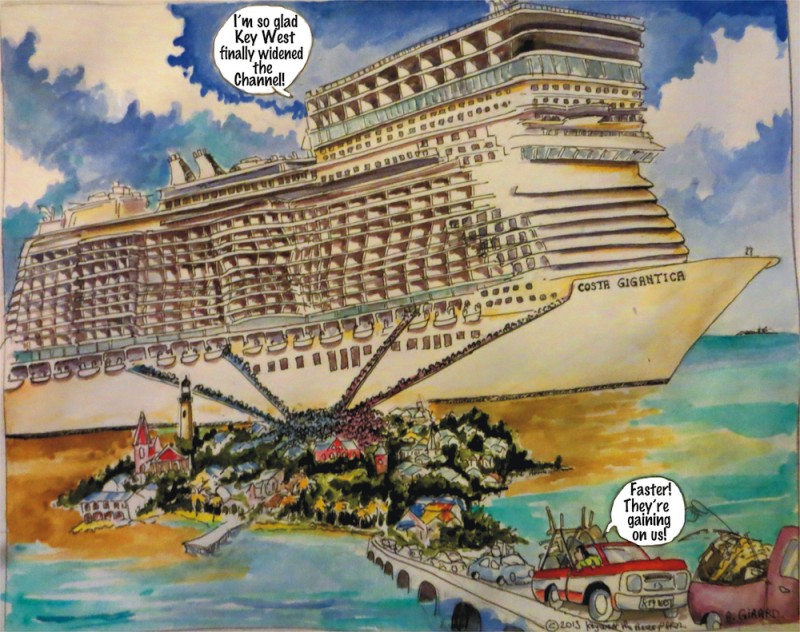Sei Fuori di testa?
by Naja and Arnaud Girard…….
In the game of “my boat is bigger than your boat”, cruise ship companies have truly come up with some gargantuan concepts. Ships carrying over 5000 people (nearly double the capacity of most cruise ships now docking in Key West) are trying to make their way into our harbor.
They’re out there on the other side of the reef; problem is they can’t get in because the channel is too narrow. As some in the community scramble to figure out how to accomplish the widening of the Main Ship Channel, some unexpected words have come from across the Atlantic – from Italy, Venice to be precise. “Sei fuori de testa?’ translates more or less to “Are you off your rocker?”
An organization opposed to gigantic ships in Venice, “Comitato No Grandi Navi” (No Big Ships) joined forces with the Key West Committee for Responsible Tourism last week. As Venice desperately tries to keep the biggest ships out, it seems incredible that we would try to bring them in.
As it turns out Venice, one of the world’s marvels, had no need to widen it’s channel. It’s plenty wide enough and as a result Venetians are literally walled in by enormous cruise ships, four or five times the height of St. Mark’s Cathedral. “These monsters obscure us,” said Matteo Casini, a professor of history who compared the ships to alien creatures. NPR correspondent Sylvia Poggioli reports, “Six ships docking at the lagoon terminal can disgorge in one day more than half the city’s population of 55,000.” The joint resolution signed in Venice and in Key West lists the various nuisances created by those huge ships in small historic harbors (overcrowding, excessive turbidity, water and air pollution, to list a few) Unlike Venice, Key West is protected by its coral reef and its narrow channel – WE have a choice. And Venice opens a window into our possible future.
An interesting lesson learned from the Venice experience is that under maritime law, once the ships can physically come into a port there may be no keeping them out. Under the Ocean Shipping Reform Act of 1998, a US port operator can’t simply turn ships away.
In Juneau, Alaska voters pushed through a referendum restricting the number of cruise ship port calls by raising disembarkation fees. Carnival Cruise lines and the Alaska Cruise Association sued and forced a settlement. Under federal law, passenger disembarkation fees are limited to fair compensation for the cruise ship’s local impact and the money collected can only be used to provide services to the cruise ship industry and its passengers.
In Venice the anti-gargantuan-ship group has mobilized to put pressure on the Italian government to limit the use of the port by gigantic cruise ships. They organized a symbolic blockade in which hundreds of people in small vessels filled the canal waving banners with the words “No Navi Grandi!” [No Big Ships!]
So before we widen the channel we should probably be really sure we would fancy a Venice scenario; there will be no turning back.
“We do not need a study to know that cruise ships are degrading the environment and character of Key West,” says former Monroe County Mayor Shirley Freeman, “Hordes of cruise ship passengers discourage higher income tourists who stay days and weeks and benefit the economy many times more.”
A study completed in 2005 by Thomas J. Murray regarding the impact of cruise ships on the Key West community showed that, at that time, tourists from cruise ships spent an average of $32/trip while other visitors spent about $446/trip. This includes meals, hotel rooms, charter fishing, diving, sightseeing, etc.; many activities that cruise ship passengers, who the study says spend an average of 3 hours on the island, don’t have any need for or time to do.
But Jennifer Hulse, attorney and spokesperson for the ‘Support The Study’ PAC disagrees. She claimed during a Key West Citizen interview back in May that the study “would be an extremely detailed analysis of nearly every impact channel widening would have on the island: Environmental, social issues, quality of life and legal issues. It’s a wealth of information.”
That sounds like the kind of study we would want. Unfortunately, it is not what the Army Corp study is designed to do. Under federal guidelines a feasibility study is a tool to help the US Congress choose, from among many different projects, the ones that are the most important for US maritime interests. Last week we published a detailed statement written by Eric Bush, Chief of Planning and Policy Division, USACE Jacksonville. Bush made it clear that the study would have little to do with the ins and outs of the local economy.
In preparation for this article we reviewed feasibility studies for other harbors, like the Port Everglades study issued in June 2013, to get a better idea of what a typical channel dredging feasibility study looks like. In keeping with Mr. Bush’s explanation, those reports contained no local economic ‘studies’ to speak of.
This week we turn to the “social impacts” studies described in the Referendum.
The Principals and Guidelines that govern USACE feasibility studies leave “social effects” as an option. And there is a simple reason why this “option” will likely not be taken. Initially, the feasibility study was projected to cost nearly $6 Million, but because of budget reductions, the study has since been capped at $3 Million. Social impacts are not a priority for US Congress when it comes to Federal Water Projects.
“With respect to social impacts,” says Bush, “I do not envision that the feasibility study would go into much detail on all of the secondary social impacts… It could certainly be done, but the overall intent of establishing the scope of a USACE navigation project feasibility study is to focus study funds on evaluating those things within Corp purview for supporting an investment recommendation to Congress.”
“If the local government agreed those studies were important; those studies could still be performed (probably without federal cost-sharing), to support the overall feasibility study.”
Unbeknownst to them and based on a complete misunderstanding of what a USACE feasibility study is meant to achieve under federal guidelines, Key Westers may end up sending a message to Washington that they support the reversal of the ban on dredging in the Sanctuary. Communities that sponsor such studies usually understand that they’ve agreed to enter into a competitive process that pits their project against those of other communities. Should we really act so casual about $3 Million of taxpayer money? “It’s Just A Study!” We sound like a 17-year old girl who wants her daddy to buy her a $3,000 prom dress but still hasn’t decided if she really wants to go to the prom.
Dredging in the Sanctuary appears to be the ‘elephant in the room’ that pro-study proponents don’t want to see or talk about. If the referendum passes, a study will not provide an in-depth analysis of our local economic or social impact issues, but what it will do is give the false impression that locals support the reversal of the ban on dredging in the Sanctuary, which would help lobbyists convince lawmakers to actually lift that ban [a prerequisite to the USACE even requesting funding for a feasibility study].
In the coming week we will examine whether or not the referendum language is perhaps so misleading that it would render the referendum invalid.
~~~~~~~~~~~~~~~~~~~~~~~~~~~~
What follows is the referendum question that will appear on the October 1st ballot:
“Shall the city of Key West request that the Army Corp of Engineers conduct a comprehensive feasibility study, at no monetary cost to the city, to determine the environmental, economic and social impacts of widening the Key West Main Ship Channel for use by modern and longer cruise ships while also addressing navigational safety?”
[optin-cat id=”26188″]




Facebook Comments